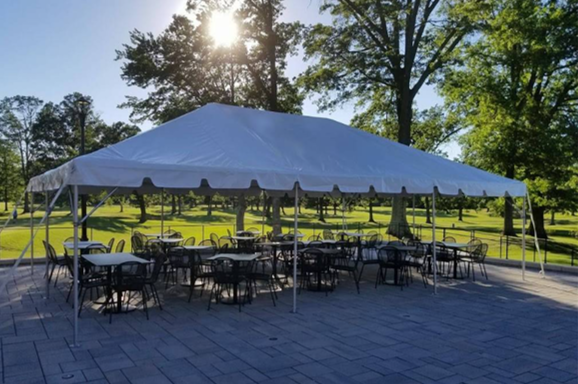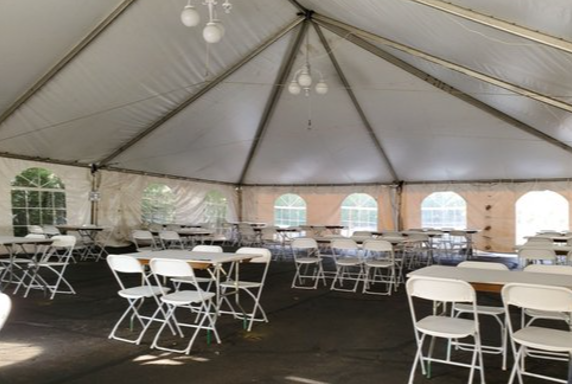SHOP BY TENT SIZE (FOR PURCHASE)
SHOP BY TENT PRICE (FOR PURCHASE)
COMPONENTS & ACCESSORIES
RESOURCE CENTER
![]()
Dining tents
Cost minded restaurant, pub and bar owners seeking outdoor shelter and overflow dining seating for their guests have quickly become aware that conventional steel and wood frame renovations and additions can be quite costly and time consuming to construct from start to finish. Due to these obstacles, frame tents have quickly become the popular outdoor shelter alternative due to their cost efficiency, portability, and ease of construction. The cost and time required to obtain building permits for a permanent building addition can add to the frustration of many restaurant and pub owners who need outdoor dining space quickly. The majority of restaurant frame tents are considered to be portable and temporary in nature which typically eliminates the need for a permit. We do recommend contacting your local zoning and building authorities prior to purchasing a restaurant overflow tent or canopy. Because of this, restaurant and bar overflow dining tents have rapidly taken hold as the cost efficient and durable solution for outdoor shelter and seating. There are a variety of dining tents available, however, the frame tents are the recommended solution for these applications. Prospective purchasers can search for dining tents by selecting the appropriate size (width) under the SHOP BY TENT SIZE area (top left).

There are a number of advantages that dining tent shelters offer when compared to the conventional wood, brick, or metal storage structure. Cost efficiency, flexibility, and ease of construction are a few of the benefits that need to be noted. When comparing the cost of a wood or steel structure, a frame tent is just a fraction of the total cost. Ease of construction is another notable advantage as these tent structures can be quickly assembled on any level mounting surface including poured concrete pads, asphalt, dirt, and gravel.

The durable framework is traditionally manufactured of round galvanized structural steel tubing or aluminum for corrosion resistance. A variety of fastening hardware such as welded steel fittings, brackets and pins are used to provide a secure and stable structure. Some manufacturers use corner bracing to provide additional stability in harsh weather environments while others use cables and other bracing mechanisms. Frame tents are typically free standing, however, a rugged anchoring system is required to secure it to the mounting surface. In general, most manufacturers provide base mounting plates which have pre drilled holes to mount to wood, steel, or concrete. These foot plates also provide for anti sink properties in moist soil conditions.
Covers are conventionally manufactured from PVC coated polyester which is heat sealed at the seams to prevent water and moisture intrusion into the tent or canopy. The majority of tent tops are manufactured from 16 oz/yd2 blockout material. Some manufacturers may use a slightly different textile such as woven coated polyethylene. Regardless of the cover material that is utilized, these materials can offer years of protection with the correct care and maintenance. Covers are tensioned tightly to the tent frame utilizing a commercial grade tensioning system that uses water resistant polyester strapping and clips depending on the design of that specific tent shelter. Decorative scalloped valances are available on most tents to provide for a more elegant appearance. Polyester straps are sewed into the cover near the framing cross members to firmly attached the cover to the frame. Proper care and maintenance is required to keep the tent cover tight to the framework. Loose covers can cause moisture and debris to gather in certain areas which can reduce the life expectancy of the canopy cover. It is also important to keep any debris such as sharp objects from collecting on the cover as this can reduce cover life expectancy. Debris such as tree limbs and sticks can be especially harmful to the tent.
Another benefit of outdoor seating tents is the sidewalls can be rolled up to provide for more interior natural lighting, air flow, and outdoor dining viewing. Sidewalls are also available in window option to maintain a fully enclosed condition and allow more interior lighting for dining guests. Each tent and canopy has a preinstalled rope along the perimeter for the sidewalls and enclosures to be easily removed and reinstalled to the tent. Additional lighting and decorations can also be installed to the tent to allow for a more enhanced interior appearance.
